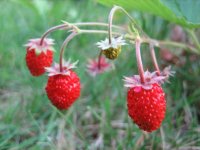Wild strawberry forest - fracaria vesca l.
Family Rosaceae - Rosaceae
Botanical characteristics. Perennial herbaceous plant. Rhizome with many accessory roots. Stems of two kinds: one - recumbent, rooting, others - erect, flowering, leafy. Leaves are triple, large, serrate, silky-wavy. Flowers are white, collected in semi-zoogrophs. Fruit is a berry with numerous seeds. Blossoms in May - June, fructifies in June - July.
Spread. It grows on the fringes, grassy slopes, forest glades.
Used parts of the plant. The medicinal raw material is the whole plant, collected in the usual way: the aerial part - during flowering, the roots - in the autumn.
Chemical composition. The aerial part contains organic acids with a predominance of citric acid, pectin and tannins, nitrogenous compounds, trace elements, vitamins (ascorbic and folic acids, carotene, group B), flavonoids (quercetin, quercitin, rutin), phenolic acids (chlorogenic, salicylic, Glucuronic, quinine, coffee, fumaric). The roots contain leucoanthocyanins and catechins.
Application. Strawberries, along with St. John's wort, birch, elephant, chamomile and plantain - one of the most used medicinal plants of folk medicine.
In folk medicine, infusions and decoctions, juices of fresh berries are used as a diaphoretic and diuretic, to improve digestion. Decoction of the leaves - in diseases of the cardiovascular system, as a restorative. Decoctions of the aboveground part and roots are used for pulmonary tuberculosis, bronchial asthma, urolithiasis, gout, hemorrhoids, uterine fibroids, insomnia, diarrhea, diabetes, for the prevention and treatment of atherosclerosis, for beriberi, for skin diseases accompanied by a rash, as a diuretic, astringent .
The therapeutic effect of drugs and fresh strawberry fruits has been established in certain diseases of the cardiovascular system, hypertension, gastrointestinal diseases, gastritis, peptic ulcer, hemorrhoids, constipation, jaundice. The infusion of strawberry leaves slows down the rhythm and enhances the amplitude of the heartbeats, dilates the blood vessels. It is used as an anesthetic, spasmolytic for neurasthenia, leukemia, enuresis, laryngeal carcinomas.
Broth of flowers and tincture are used for metabolic disorders, diseases of the cardiovascular system.
Dried and fresh fruits are widely used in Tibetan medicine, fresh - in homeopathy in various diseases, mainly to stimulate appetite in weakened people after illness. Fresh juice of fruits and leaves has antibacterial properties. It is used in cosmetics to remove acne, pigment spots, as an antiseptic.
Preparation
- For infusion take 20 g of leaves and flowers, pour 200 ml of boiling water, insist on the bath for 15 minutes, cool 45 minutes, filter. Take 1/3 cup 3 times daily after meals.
- For broth 15 g of roots and aerial parts are poured 200 ml of boiling water, insist on a water bath for 30 minutes, cool for 10 minutes, filter. Take 1/3 cup 2-3 times a day after meals.
- Fresh juice is an excellent cosmetic.
Contraindications. An increased individual sensitivity in some patients to strawberries, which is manifested in allergic diseases. Wild strawberries can be replaced by healing properties cultivated varieties.




Comments
When commenting on, remember that the content and tone of your message can hurt the feelings of real people, show respect and tolerance to your interlocutors even if you do not share their opinion, your behavior in the conditions of freedom of expression and anonymity provided by the Internet, changes Not only virtual, but also the real world. All comments are hidden from the index, spam is controlled.